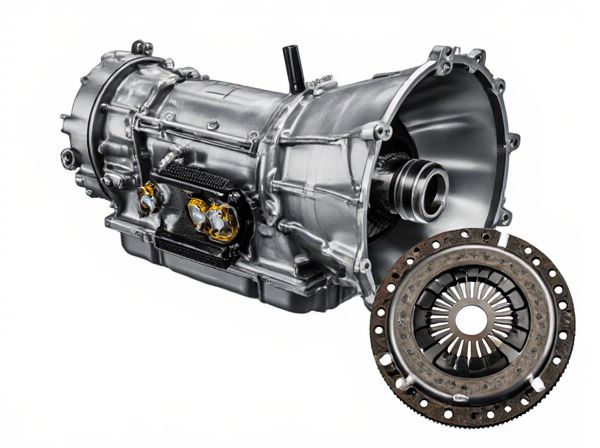
Photo illustration: Torque converter vs Clutch pack
Torque converters provide smooth and continuous power transfer by using fluid dynamics, making them ideal for automatic transmissions with less wear and seamless gear changes. Clutch packs rely on friction plates to engage and disengage power, offering more direct control and efficiency, commonly found in manual and dual-clutch transmissions. You should consider torque converters for comfort and ease of use, while clutch packs are better suited for performance and precise shifting.
Table of Comparison
| Feature | Torque Converter | Clutch Pack |
|---|---|---|
| Function | Hydraulic fluid coupling for smooth power transfer | Mechanical friction plates for direct connection |
| Efficiency | Moderate efficiency, some energy loss in fluid | High efficiency, minimal power loss |
| Smoothness | Very smooth gear shifts, absorbs shocks | Less smooth, potential for harsh shifts |
| Durability | Long-lasting, requires fluid maintenance | Wear on clutch plates, periodic replacement needed |
| Common Use | Automatic transmissions in passenger cars | Dual-clutch and automated manual transmissions |
| Cost | Generally higher initial cost and complexity | Lower cost but higher maintenance expense |
Introduction to Torque Converter and Clutch Pack
A torque converter is a hydraulic device used in automatic transmissions to transfer and multiply engine torque, providing smooth acceleration without manual gear changes. A clutch pack, commonly found in manual and dual-clutch transmissions, consists of multiple friction plates that engage and disengage to control power flow and enable gear shifts. Both components play essential roles in vehicle drivetrains, optimizing performance and efficiency by managing power delivery differently depending on transmission type.
How Torque Converters Work
Torque converters use a fluid coupling mechanism to transfer engine power to the transmission, allowing smooth acceleration without direct mechanical connection. They consist of three main components: the impeller, turbine, and stator, which work together to multiply torque and provide hydraulic power transmission. Unlike clutch packs that rely on friction to engage gears, torque converters enable variable torque multiplication and absorb engine vibrations for seamless power delivery.
How Clutch Packs Function
Clutch packs function by using multiple friction plates pressed together to transmit engine power smoothly in automatic and dual-clutch transmissions. When hydraulic pressure is applied, the clutch pack engages, allowing controlled torque transfer and precise gear shifts without slippage. This mechanism enhances driving efficiency and performance compared to a torque converter, which relies on fluid dynamics to transmit power.
Key Differences Between Torque Converter and Clutch Pack
Torque converters use fluid coupling to transmit engine power smoothly, allowing for seamless acceleration and torque multiplication, while clutch packs rely on friction plates to engage and disengage power transfer mechanically. Torque converters are common in automatic transmissions and provide smoother shifting, whereas clutch packs are typically found in dual-clutch and manual transmissions, offering more direct power delivery and faster response. Key differences include the method of power transfer--hydraulic versus mechanical--and the resulting impact on driving dynamics, fuel efficiency, and maintenance requirements.
Efficiency and Performance Comparison
Torque converters provide smooth power transfer and better shock absorption but often suffer from efficiency losses due to fluid coupling slippage, resulting in lower fuel economy compared to clutch packs. Clutch packs offer direct mechanical engagement, minimizing energy loss and improving overall transmission efficiency and performance responsiveness. High-performance vehicles favor clutch packs for quicker power delivery and reduced heat generation, while torque converters excel in comfort and drivability under varying load conditions.
Maintenance Requirements and Longevity
Torque converters generally require less frequent maintenance due to their sealed design and fluid coupling, which reduces wear and extends operational life. Clutch packs demand more regular inspection and adjustment to prevent friction material degradation and ensure consistent performance under high torque conditions. Proper maintenance of clutch packs often includes monitoring fluid quality and replacing worn plates, while torque converters rely mainly on periodic transmission fluid changes to maintain longevity.
Applications in Modern Vehicles
Torque converters are primarily used in automatic transmissions of modern passenger cars and SUVs, providing smooth torque multiplication and seamless power transfer at varying engine speeds. Clutch packs are common in dual-clutch and automated manual transmissions, offering rapid gear shifts and improved fuel efficiency, particularly in sports cars and performance vehicles. Both systems play critical roles in optimizing drivability and fuel economy, catering to different driving styles and vehicle requirements.
Pros and Cons of Torque Converters
Torque converters provide smooth power transfer and allow seamless acceleration without manual gear changes, enhancing driving comfort in automatic transmissions. They offer superior torque multiplication at low speeds, improving vehicle launch and hill climbing capabilities, but their hydraulic nature can reduce fuel efficiency and generate heat under heavy loads. Maintenance is generally less frequent compared to clutch packs, yet torque converters may experience more slippage and slower response times, affecting overall drivetrain performance.
Pros and Cons of Clutch Packs
Clutch packs provide smoother and more efficient power transfer by directly locking the transmission components, leading to reduced slippage and improved fuel economy compared to torque converters. However, clutch packs are prone to wear and require precise hydraulic control, which can result in costly repairs and maintenance over time. Their performance excels in applications demanding quick and firm gear shifts but may lack the torque multiplication benefits found in torque converters.
Choosing the Right System for Your Needs
Selecting between a torque converter and a clutch pack depends on your vehicle's performance requirements and driving style. Torque converters provide smooth power delivery and are ideal for automatic transmissions, offering better shock absorption and ease of use in stop-and-go traffic. Clutch packs deliver more direct power transfer and higher efficiency, making them suitable for performance-oriented vehicles and manual gearbox applications.
 caratoz.com
caratoz.com